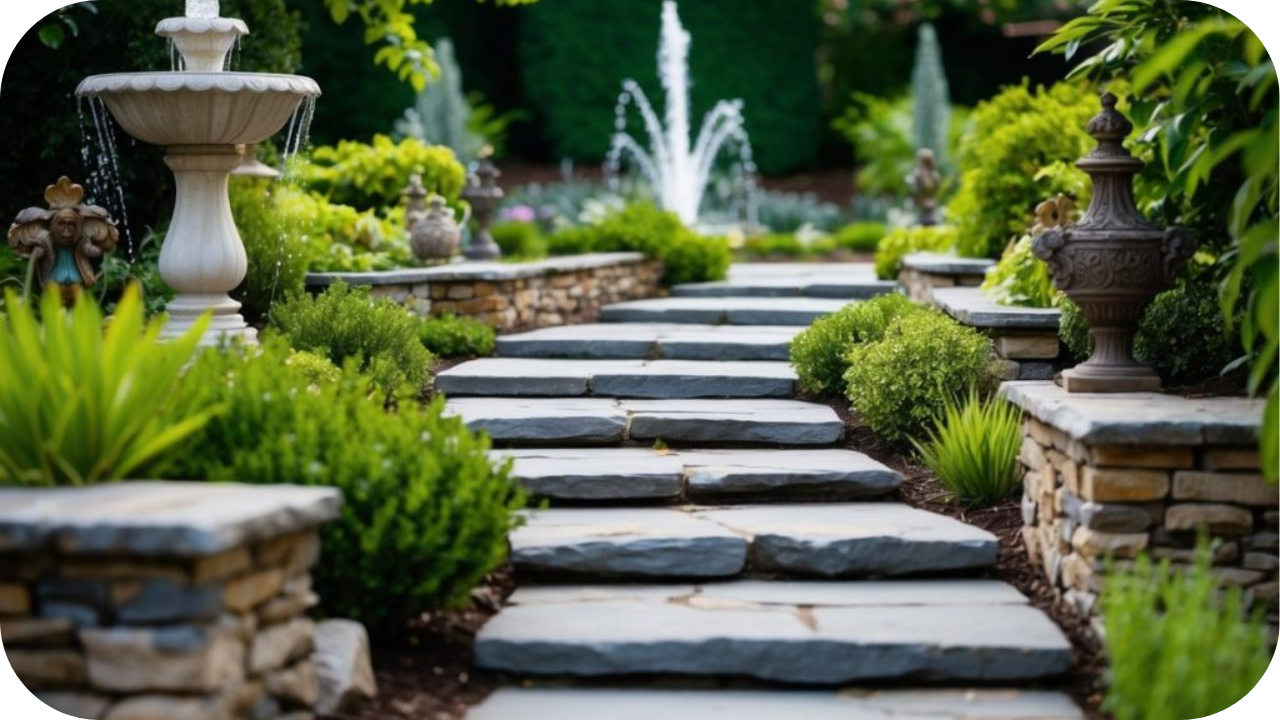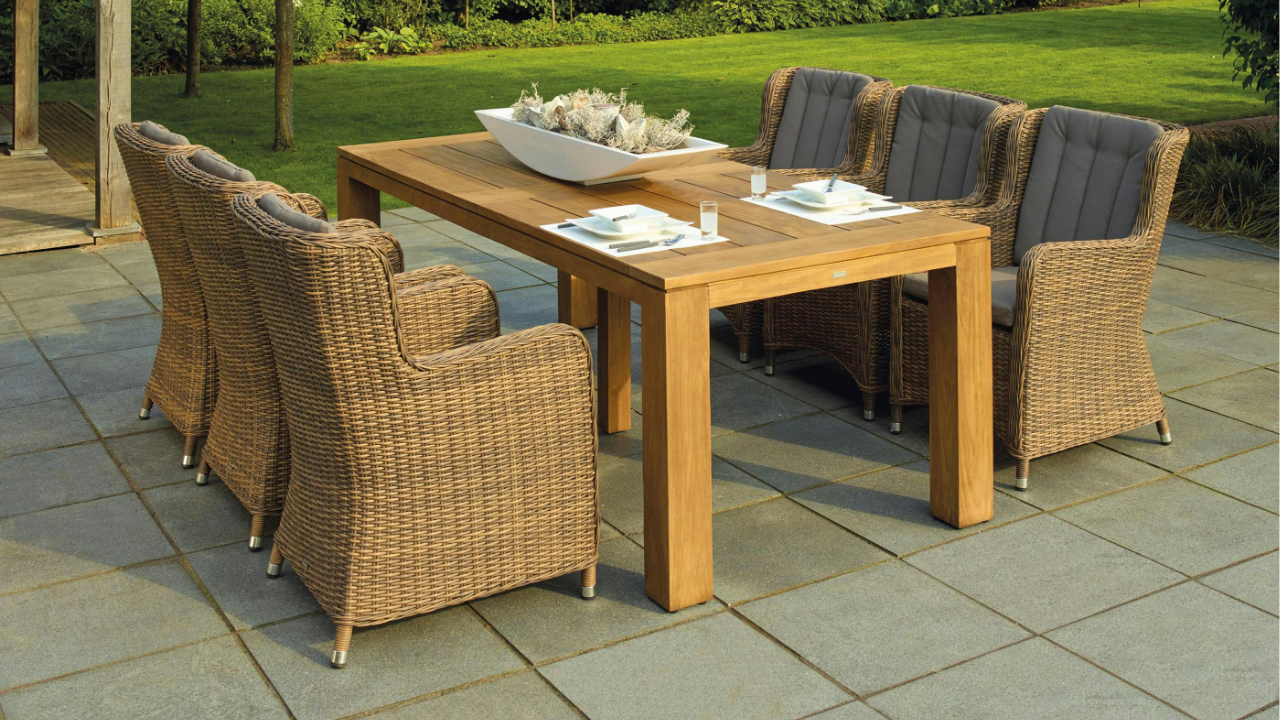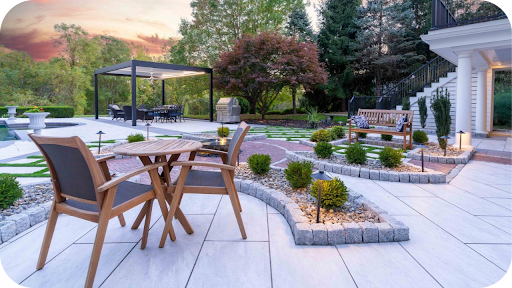
A beautifully designed garden combines structure, texture, and lasting materials. Natural stone stands out as a reliable choice for creating outdoor spaces that feel elegant, functional, and connected to the landscape.
Its natural variation, strength, and ability to suit any style make it a top material for both professionals and homeowners.
In this article, you’ll learn how to design a stunning garden using natural stone. We’ll cover key benefits, popular stone types, layout ideas, installation tips, and how to care for your stone features.
Why Use Natural Stone in Your Garden Design

Not all landscaping materials are created equal. Natural stone brings unmatched beauty and performance to garden spaces. Here’s why natural stone is a top choice for lasting outdoor design.
1. Natural Aesthetics That Complement Any Garden Style
Natural stone blends seamlessly with formal, native, modern, and coastal garden designs. Its organic colours, textures, and shapes create a grounded, timeless look that enhances both softscaping and built structures.
2. Strength and Resilience in Outdoor Environments
Natural stone withstands Australia’s harsh weather, from intense sun to heavy rainfall. It handles foot traffic, pressure, and daily use without cracking or fading, making it ideal for high-traffic zones and long-term landscaping.
3. Minimal Upkeep with Long-Lasting Results
Unlike many synthetic materials, stone ages well with minimal maintenance. Occasional cleaning and resealing keep it looking sharp, offering a low-effort way to preserve your garden’s appearance across the seasons.
4. Sustainable and Value-Adding Material Choice
Stone is a natural, low-impact material with a long lifespan. Its durability and premium finish can increase your property’s value, making it a smart choice for eco-conscious and investment-focused homeowners alike.
5. Versatile for Both Structural and Decorative Use
Natural stone suits a wide range of garden applications. It works just as well in retaining walls and paving as it does in pathways, edging, water features, and decorative accents throughout the landscape.
Tips for Planning Your Garden Design with Natural Stone

Great garden design starts with smart planning. Before selecting your materials, consider these practical tips to ensure your layout, stone choices, and flow come together beautifully.
1. Assess the Layout, Size, and Natural Features of Your Garden
Take note of slopes, shade, drainage, and natural contours. Understanding your garden’s layout will help determine where stone features fit best and how to balance structure with open, plant-filled spaces.
2. Match Stone Choices to Garden Styles
Your stone should complement your garden’s overall design theme. Sleek cuts and cool tones suit contemporary spaces, while warm, textured stones pair well with rustic, native, or Mediterranean-style gardens.
3. Consider Sun Exposure, Flow, and Function
Identify areas that receive the most sun, foot traffic, or require access. Use stone to guide movement, define zones, and create functional pathways that connect key points throughout the garden.
4. Blend Stone Colour and Texture with Surrounding Elements
Choose stones that complement your home’s exterior, nearby plants, and hardscape features. A consistent palette of colour and texture ensures visual flow and a cohesive design from every angle.
5. Think Long-Term When Choosing Materials
Select stone that will weather well and remain visually appealing for years to come. Consider durability, slip resistance, and whether the finish will age gracefully in your specific climate and setting.
Best Types of Natural Stone for Gardens

Not all stones suit every garden. The right choice depends on your design, climate, and intended use. Here are some of the best natural stones to consider for outdoor spaces.
- Bluestone: Bluestone is a dense, hard-wearing stone ideal for paths, patios, and paving. Its fine texture and blue-grey tones suit both modern and classic gardens, offering a naturally slip-resistant surface for foot traffic.
- Porphyry: Porphyry is a richly textured volcanic stone perfect for pathways, borders, and driveways. Its unique blend of earthy colours adds a rustic, natural feel to gardens while performing well under heavy use.
- Granite: Granite is an exceptionally durable stone used for steps, benches, and structural features. Its strength, range of colours, and resistance to moisture and heat make it a reliable choice for high-traffic garden areas.
- Limestone: Limestone is a soft-toned stone that suits traditional, formal, or coastal gardens. Its smooth finish and natural warmth make it a beautiful choice for patios, feature walls, or edging when sealed properly.
- Travertine: Travertine is a textured stone that blends elegance and earthiness. It stays cool underfoot and is often used for pool surrounds, garden steps, and outdoor entertaining zones in relaxed, timeless settings.
- Quartzite: Quartzite is a shimmering, resilient stone ideal for walkways, vertical features, or paving. It offers the natural beauty of marble with superior durability, making it a standout in modern or minimalist landscapes.
Creative Ideas for Using Natural Stone in Garden Landscaping

Stone is more than just a surface; it’s a design element. From structure to detail, here’s how you can use natural stone to elevate your outdoor space.
1. Garden Paths and Stepping Stones
Use natural stone to guide movement through your garden. Irregular flagstones or neatly placed stepping stones create organic flow while adding texture, visual interest, and a practical walking surface between garden zones.
2. Stone Edging and Lawn Borders
Define flower beds or lawn edges with stone setts or strips. This adds a clean finish, prevents soil spillover, and creates a subtle visual frame that separates hardscapes from planted areas.
3. Retaining Walls and Raised Garden Beds
Use natural stone blocks to build raised beds or hold back sloped areas. These features provide structure, improve drainage, and create level planting zones while enhancing the garden’s visual depth.
4. Natural Stone Patios and Entertaining Zones
Create a stylish patio using large-format pavers or mixed-stone layouts. Ideal for dining, lounging, or entertaining, a stone patio adds permanence and character to your outdoor living areas.
5. Feature Walls and Privacy Screens
Stacked stone or cladded panels create beautiful backdrops or boundaries. Use them to frame outdoor zones, add texture to flat areas, or introduce height for privacy and garden layering.
6. Stone Benches and Built-In Seating
Incorporate built-in stone benches or freestanding seats into your landscape. These durable features provide function and form, offering rest spots that complement surrounding garden paths or planted areas.
7. Water Features and Pond Surrounds
Use stone to line ponds, waterfalls, or fountains. Whether you prefer smooth edges or natural rock arrangements, stone adds a grounding element and enhances the calming effect of water features.
Installation Tips for Natural Stone in Outdoor Spaces

Good installation makes all the difference. Use these tips to ensure your stonework is both beautiful and built to last.
- Select the right stone format: Choose formats suited to your project. Pavers work for patios, cobbles for edging, and walling stone for vertical features. Matching the right format to the right space ensures long-term success.
- Prepare a stable base: A properly compacted base of gravel or crushed rock prevents shifting. Level ground and good drainage are essential to keep your stonework safe, stable, and looking sharp over time.
- Use the right tools and adhesives: For lasting results, use stone-specific adhesives, spacers, and cutting tools. This improves alignment and bonding, especially in high-use areas like stairs, walls, and paved zones.
- Know when to DIY and when to hire a professional: While small projects like edging can be DIY-friendly, larger installations such as patios, walls, or steps are best handled by experienced landscapers or stonemasons.
Maintenance Tips for Natural Stone in Gardens

Natural stone is low maintenance, but a little care goes a long way. Keep your garden features looking their best with these easy upkeep tips.
- Sweep and rinse regularly: Remove leaves, dirt, and organic debris with a broom or low-pressure hose. Routine cleaning prevents build-up, discolouration, and slipping, helping your stone surfaces stay clean and safe year-round.
- Reseal porous stones when needed: Stones like limestone and travertine benefit from resealing every one to two years. A quality sealer protects against moisture, stains, and weather damage, extending the life of your stone.
- Control weeds between joints or edges: Use weed matting, joint fillers, or compacted base layers to reduce growth. Regular weeding keeps your pathways neat and prevents long-term damage from root intrusion.
- Repair shifting or damage promptly: Address loose stones, cracks, or surface chips early to avoid further deterioration. Timely fixes ensure your stonework remains safe, structurally sound, and visually polished over time.
- Avoid harsh chemical cleaners: Stick to pH-neutral cleaning solutions. Acidic or abrasive products can erode sealants and damage the stone’s finish, especially on softer materials like limestone and travertine.
- Protect surfaces during seasonal changes: Use covers or reposition movable features during extreme weather. Heavy rain, frost, or prolonged heat can accelerate wear, so seasonal care helps your stone last longer.
Conclusion
Natural stone adds beauty, structure, and long-term value to your garden. With the right planning and care, it creates outdoor spaces that feel both elegant and enduring.
Looking to upgrade your garden with stone? Speak to the experts at Splendour in Stone for premium materials and tailored advice to bring your landscape vision to life.
More To Explore

Top 10 DIY Projects to Upgrade Your Backyard
More homeowners are paying attention to their outdoor spaces as backyards become important living areas. This shift highlights a desire for comfort, better use of

What Are the Best Permeable Pavers for Drainage?
Heavy rain can quickly turn a beautiful outdoor space into a frustrating pool of standing water. Many homes face similar drainage issues, especially in high-traffic


